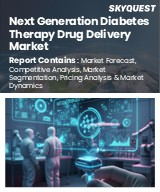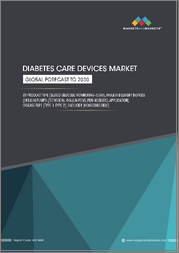
|
시장보고서
상품코드
1728338
세계의 비주사 인슐린 시장 : 산업 규모, 점유율, 동향, 기회, 예측 - 제품별, 유통 채널별, 지역별, 경쟁별 부문(2020-2030년)Non-Injectable Insulin Market - Global Industry Size, Share, Trends, Opportunity, and Forecast, Segmented By Product, By Distribution Channel, By Region and Competition, 2020-2030F |
||||||
세계의 비주사 인슐린 시장은 2024년에 31억 4,000만 달러로 평가되었고, 2030년에는 54억 5,000만 달러에 이를 전망이며, 예측 기간 동안 CAGR 9.63%를 보일 것으로 예측됩니다.
이 시장에는 주사 바늘을 사용하지 않고 투여할 수 있도록 설계된 인슐린 제제가 포함되어 있으며 기존 주사에 의한 투여를 대체할 수 있는 옵션을 제공합니다. 비주사 인슐린의 옵션(경구정제, 흡입 가능한 제제, 스프레이, 패치 등)은 환자의 애드히어런스와 QOL을 향상시키기 위해 개발되었으며, 특히 주사에 과제를 안고 있는 환자에게 중요합니다. 이러한 전달 시스템은 효과적인 혈당 컨트롤을 유지하면서 보다 사용하기 쉬운 경험을 제공하는 것을 목표로 하고 있습니다. 예를 들어 오라메드사의 경구 인슐린 제제 후보 ORMD-0801은 주요 평가 항목을 달성하지 못했고, 바이오콘사는 1형 당뇨병을 대상으로 한 트레고필의 제1상 시험을 중지했습니다. 그러나 지속적인 기술 혁신과 환자 중심의 제품 개발로 비주사 인슐린 요법은 당뇨병 관리의 유력한 선택지로 지지될 것으로 기대됩니다.
| 시장 개요 | |
|---|---|
| 예측 기간 | 2026-2030년 |
| 시장 규모(2024년) | 31억 4,000만 달러 |
| 시장 규모(2030년) | 54억 5,000만 달러 |
| CAGR(2025-2030년) | 9.63% |
| 급성장 부문 | 약국 |
| 최대 시장 | 북미 |
시장 성장 촉진요인
혈당 조절 개선
주요 시장 과제
유효성 및 안전성에 대한 우려
주요 시장 동향
개인화 치료 접근법
목차
제1장 개요
제2장 조사 방법
제3장 주요 요약
제4장 고객의 목소리
제5장 세계의 비주사 인슐린 시장 전망
- 시장 규모 및 예측
- 금액별
- 시장 점유율 및 예측
- 제품별(정제, 스프레이 등)
- 유통 채널별(병원 약국, 온라인 약국, 약국)
- 지역별(북미, 유럽, 아시아태평양, 남미, 중동 및 아프리카)
- 기업별(2024년)
- 시장 맵
- 제품별
- 유통 채널별
- 지역별
제6장 북미의 비주사 인슐린 시장 전망
- 시장 규모 및 예측
- 시장 점유율 및 예측
- 북미 : 국가별 분석
- 미국
- 캐나다
- 멕시코
제7장 유럽의 비주사 인슐린 시장 전망
- 시장 규모 및 예측
- 시장 점유율 및 예측
- 유럽 : 국가별 분석
- 프랑스
- 독일
- 영국
- 이탈리아
- 스페인
제8장 아시아태평양의 비주사 인슐린 시장 전망
- 시장 규모 및 예측
- 시장 점유율 및 예측
- 아시아태평양 : 국가별 분석
- 중국
- 인도
- 일본
- 한국
- 호주
제9장 남미의 비주사 인슐린 시장 전망
- 시장 규모 및 예측
- 시장 점유율 및 예측
- 남미 : 국가별 분석
- 브라질
- 아르헨티나
- 콜롬비아
제10장 중동 및 아프리카의 비주사 인슐린 시장 전망
- 시장 규모 및 예측
- 시장 점유율 및 예측
- 중동 및 아프리카 : 국가별 분석
- 남아프리카
- 사우디아라비아
- 아랍에미리트(UAE)
제11장 시장 역학
- 성장 촉진요인
- 과제
제12장 시장 동향 및 발전
- 최근 동향
- 합병 및 인수
- 제품 출시
제13장 세계의 비주사 인슐린 시장 : SWOT 분석
제14장 Porter's Five Forces 분석
- 업계 내 경쟁
- 신규 진입의 가능성
- 공급자의 힘
- 고객의 힘
- 대체품의 위협
제15장 경쟁 구도
- Midatech Pharma Plc
- Shreya Life Sciences Pvt. Ltd.
- Boston Therapeutics, Inc.
- Coromed, Inc.
- Diabetology Ltd.
- Emisphere Technologies, Inc.
- Oramed Pharmaceuticals, Inc.
- Diasome Pharmaceuticals, Inc.
- Generex Biotechnology Corp.
- Biodel, Inc.
제16장 전략적 제안
제17장 기업 소개 및 면책사항
AJY 25.05.27The Global Non-Injectable Insulin Market was valued at USD 3.14 Billion in 2024 and is projected to reach USD 5.45 Billion by 2030, growing at a CAGR of 9.63% during the forecast period. This market encompasses insulin formulations designed to be administered without needles, offering alternatives to traditional injection-based delivery. Non-injectable insulin options-such as oral pills, inhalable forms, sprays, and patches-are being developed to improve patient adherence and quality of life, especially for individuals who face challenges with injections. These delivery systems aim to offer a more user-friendly experience while maintaining effective blood glucose control. Despite the promise, the market faces hurdles due to clinical setbacks; for instance, Oramed Pharmaceuticals' oral insulin candidate ORMD-0801 failed to meet its primary endpoint, and Biocon halted a Phase 1 trial of Tregopil for Type 1 diabetes. However, with continued innovation and patient-centric product development, non-injectable insulin therapies are expected to gain traction as a viable alternative for diabetes management.
| Market Overview | |
|---|---|
| Forecast Period | 2026-2030 |
| Market Size 2024 | USD 3.14 Billion |
| Market Size 2030 | USD 5.45 Billion |
| CAGR 2025-2030 | 9.63% |
| Fastest Growing Segment | Drug Stores |
| Largest Market | North America |
Key Market Drivers
Improved Glycemic Control
Enhanced glycemic control is a pivotal driver of growth in the Global Non-Injectable Insulin Market. Traditional injectable insulin can be uncomfortable, often leading to poor compliance. Non-injectable delivery systems address this by offering less invasive options, improving patient adherence and reducing anxiety associated with needle use. These alternatives also support earlier initiation of insulin therapy, allowing better management of blood glucose levels and delaying the progression of diabetes-related complications. By accommodating patients with physical limitations or needle aversion, these technologies increase treatment accessibility and improve health outcomes. The availability of user-friendly insulin forms also encourages adoption among previously reluctant patient populations, thereby expanding the market base and accelerating growth.
Key Market Challenges
Efficacy and Safety Concerns
Concerns over the effectiveness and safety of non-injectable insulin continue to hinder broader market adoption. While these alternatives promise improved convenience, they must demonstrate clinical efficacy equivalent to traditional injections to gain widespread acceptance. Issues such as variable absorption rates and inconsistent glucose control can create doubts among healthcare professionals. Furthermore, the potential for unknown long-term side effects associated with newer delivery technologies adds to skepticism. Regulatory bodies require robust evidence to approve such therapies, and without it, product launches may be delayed or restricted. This uncertainty affects physician confidence and limits patient uptake, ultimately restraining market expansion.
Key Market Trends
Personalized Treatment Approaches
The growing trend toward personalized medicine is significantly shaping the Global Non-Injectable Insulin Market. Tailoring treatment strategies to individual patient needs-considering factors like lifestyle, age, comorbidities, and psychological preferences-enhances therapy adherence and outcomes. Non-injectable insulin options provide flexibility that supports this personalization. For instance, oral formulations may better suit elderly patients with dexterity issues, while sprays may appeal to younger demographics seeking ease and discretion. Customized treatment protocols that incorporate these delivery systems can minimize patient discomfort and improve disease management. This trend aligns with the broader healthcare movement toward patient-centered care and is expected to contribute significantly to the market's long-term growth.
Key Market Players
- Midatech Pharma Plc
- Shreya Life Sciences Pvt. Ltd.
- Boston Therapeutics, Inc.
- Coromed, Inc.
- Diabetology Ltd.
- Emisphere Technologies, Inc.
- Oramed Pharmaceuticals, Inc.
- Diasome Pharmaceuticals, Inc.
- Generex Biotechnology Corp.
- Biodel, Inc.
Report Scope:
In this report, the Global Non-Injectable Insulin Market has been segmented into the following categories, in addition to the industry trends which have also been detailed below:
Non-Injectable Insulin Market, By Product:
- Pills
- Sprays
- Others
Non-Injectable Insulin Market, By Distribution Channel:
- Hospital Pharmacies
- Online Pharmacies
- Drug Stores
Non-Injectable Insulin Market, By Region:
- North America
- United States
- Canada
- Mexico
- Europe
- France
- United Kingdom
- Italy
- Germany
- Spain
- Asia-Pacific
- China
- India
- Japan
- Australia
- South Korea
- South America
- Brazil
- Argentina
- Colombia
- Middle East & Africa
- South Africa
- Saudi Arabia
- UAE
Competitive Landscape
Company Profiles: Detailed analysis of the major companies present in the Global Non-Injectable Insulin Market.
Available Customizations:
Global Non-Injectable Insulin Market report with the given market data, TechSci Research offers customizations according to a company's specific needs. The following customization options are available for the report:
Company Information
- Detailed analysis and profiling of additional market players (up to five).
Table of Contents
1. Product Overview
- 1.1. Market Definition
- 1.2. Scope of the Market
- 1.2.1. Markets Covered
- 1.2.2. Years Considered for Study
- 1.2.3. Key Market Segmentations
2. Research Methodology
- 2.1. Objective of the Study
- 2.2. Baseline Methodology
- 2.3. Key Industry Partners
- 2.4. Major Association and Secondary Sources
- 2.5. Forecasting Methodology
- 2.6. Data Triangulation & Validation
- 2.7. Assumptions and Limitations
3. Executive Summary
- 3.1. Overview of the Market
- 3.2. Overview of Key Market Segmentations
- 3.3. Overview of Key Market Players
- 3.4. Overview of Key Regions/Countries
- 3.5. Overview of Market Drivers, Challenges, Trends
4. Voice of Customer
5. Global Non-Injectable Insulin Market Outlook
- 5.1. Market Size & Forecast
- 5.1.1. By Value
- 5.2. Market Share & Forecast
- 5.2.1. By Product (Pills, Sprays, and Others)
- 5.2.2. By Distribution Channel (Hospital Pharmacies, and Online Pharmacies, Drug Stores)
- 5.2.3. By Region (North America, Europe, Asia Pacific, South America, Middle East & Africa)
- 5.2.4. By Company (2024)
- 5.3. Market Map
- 5.3.1. By Product
- 5.3.2. By Distribution Channel
- 5.3.3. By Region
6. North America Non-Injectable Insulin Market Outlook
- 6.1. Market Size & Forecast
- 6.1.1. By Value
- 6.2. Market Share & Forecast
- 6.2.1. By Product
- 6.2.2. By Distribution Channel
- 6.2.3. By Country
- 6.3. North America: Country Analysis
- 6.3.1. United States Non-Injectable Insulin Market Outlook
- 6.3.1.1. Market Size & Forecast
- 6.3.1.1.1. By Value
- 6.3.1.2. Market Share & Forecast
- 6.3.1.2.1. By Product
- 6.3.1.2.2. By Distribution Channel
- 6.3.1.1. Market Size & Forecast
- 6.3.2. Canada Non-Injectable Insulin Market Outlook
- 6.3.2.1. Market Size & Forecast
- 6.3.2.1.1. By Value
- 6.3.2.2. Market Share & Forecast
- 6.3.2.2.1. By Product
- 6.3.2.2.2. By Distribution Channel
- 6.3.2.1. Market Size & Forecast
- 6.3.3. Mexico Non-Injectable Insulin Market Outlook
- 6.3.3.1. Market Size & Forecast
- 6.3.3.1.1. By Value
- 6.3.3.2. Market Share & Forecast
- 6.3.3.2.1. By Product
- 6.3.3.2.2. By Distribution Channel
- 6.3.3.1. Market Size & Forecast
- 6.3.1. United States Non-Injectable Insulin Market Outlook
7. Europe Non-Injectable Insulin Market Outlook
- 7.1. Market Size & Forecast
- 7.1.1. By Value
- 7.2. Market Share & Forecast
- 7.2.1. By Product
- 7.2.2. By Distribution Channel
- 7.2.3. By Country
- 7.3. Europe: Country Analysis
- 7.3.1. France Non-Injectable Insulin Market Outlook
- 7.3.1.1. Market Size & Forecast
- 7.3.1.1.1. By Value
- 7.3.1.2. Market Share & Forecast
- 7.3.1.2.1. By Product
- 7.3.1.2.2. By Distribution Channel
- 7.3.1.1. Market Size & Forecast
- 7.3.2. Germany Non-Injectable Insulin Market Outlook
- 7.3.2.1. Market Size & Forecast
- 7.3.2.1.1. By Value
- 7.3.2.2. Market Share & Forecast
- 7.3.2.2.1. By Product
- 7.3.2.2.2. By Distribution Channel
- 7.3.2.1. Market Size & Forecast
- 7.3.3. United Kingdom Non-Injectable Insulin Market Outlook
- 7.3.3.1. Market Size & Forecast
- 7.3.3.1.1. By Value
- 7.3.3.2. Market Share & Forecast
- 7.3.3.2.1. By Product
- 7.3.3.2.2. By Distribution Channel
- 7.3.3.1. Market Size & Forecast
- 7.3.4. Italy Non-Injectable Insulin Market Outlook
- 7.3.4.1. Market Size & Forecast
- 7.3.4.1.1. By Value
- 7.3.4.2. Market Share & Forecast
- 7.3.4.2.1. By Product
- 7.3.4.2.2. By Distribution Channel
- 7.3.4.1. Market Size & Forecast
- 7.3.5. Spain Non-Injectable Insulin Market Outlook
- 7.3.5.1. Market Size & Forecast
- 7.3.5.1.1. By Value
- 7.3.5.2. Market Share & Forecast
- 7.3.5.2.1. By Product
- 7.3.5.2.2. By Distribution Channel
- 7.3.5.1. Market Size & Forecast
- 7.3.1. France Non-Injectable Insulin Market Outlook
8. Asia-Pacific Non-Injectable Insulin Market Outlook
- 8.1. Market Size & Forecast
- 8.1.1. By Value
- 8.2. Market Share & Forecast
- 8.2.1. By Product
- 8.2.2. By Distribution Channel
- 8.2.3. By Country
- 8.3. Asia-Pacific: Country Analysis
- 8.3.1. China Non-Injectable Insulin Market Outlook
- 8.3.1.1. Market Size & Forecast
- 8.3.1.1.1. By Value
- 8.3.1.2. Market Share & Forecast
- 8.3.1.2.1. By Product
- 8.3.1.2.2. By Distribution Channel
- 8.3.1.1. Market Size & Forecast
- 8.3.2. India Non-Injectable Insulin Market Outlook
- 8.3.2.1. Market Size & Forecast
- 8.3.2.1.1. By Value
- 8.3.2.2. Market Share & Forecast
- 8.3.2.2.1. By Product
- 8.3.2.2.2. By Distribution Channel
- 8.3.2.1. Market Size & Forecast
- 8.3.3. Japan Non-Injectable Insulin Market Outlook
- 8.3.3.1. Market Size & Forecast
- 8.3.3.1.1. By Value
- 8.3.3.2. Market Share & Forecast
- 8.3.3.2.1. By Product
- 8.3.3.2.2. By Distribution Channel
- 8.3.3.1. Market Size & Forecast
- 8.3.4. South Korea Non-Injectable Insulin Market Outlook
- 8.3.4.1. Market Size & Forecast
- 8.3.4.1.1. By Value
- 8.3.4.2. Market Share & Forecast
- 8.3.4.2.1. By Product
- 8.3.4.2.2. By Distribution Channel
- 8.3.4.1. Market Size & Forecast
- 8.3.5. Australia Non-Injectable Insulin Market Outlook
- 8.3.5.1. Market Size & Forecast
- 8.3.5.1.1. By Value
- 8.3.5.2. Market Share & Forecast
- 8.3.5.2.1. By Product
- 8.3.5.2.2. By Distribution Channel
- 8.3.5.1. Market Size & Forecast
- 8.3.1. China Non-Injectable Insulin Market Outlook
9. South America Non-Injectable Insulin Market Outlook
- 9.1. Market Size & Forecast
- 9.1.1. By Value
- 9.2. Market Share & Forecast
- 9.2.1. By Product
- 9.2.2. By Distribution Channel
- 9.2.3. By Country
- 9.3. South America: Country Analysis
- 9.3.1. Brazil Non-Injectable Insulin Market Outlook
- 9.3.1.1. Market Size & Forecast
- 9.3.1.1.1. By Value
- 9.3.1.2. Market Share & Forecast
- 9.3.1.2.1. By Product
- 9.3.1.2.2. By Distribution Channel
- 9.3.1.1. Market Size & Forecast
- 9.3.2. Argentina Non-Injectable Insulin Market Outlook
- 9.3.2.1. Market Size & Forecast
- 9.3.2.1.1. By Value
- 9.3.2.2. Market Share & Forecast
- 9.3.2.2.1. By Product
- 9.3.2.2.2. By Distribution Channel
- 9.3.2.1. Market Size & Forecast
- 9.3.3. Colombia Non-Injectable Insulin Market Outlook
- 9.3.3.1. Market Size & Forecast
- 9.3.3.1.1. By Value
- 9.3.3.2. Market Share & Forecast
- 9.3.3.2.1. By Product
- 9.3.3.2.2. By Distribution Channel
- 9.3.3.1. Market Size & Forecast
- 9.3.1. Brazil Non-Injectable Insulin Market Outlook
10. Middle East and Africa Non-Injectable Insulin Market Outlook
- 10.1. Market Size & Forecast
- 10.1.1. By Value
- 10.2. Market Share & Forecast
- 10.2.1. By Product
- 10.2.2. By Distribution Channel
- 10.2.3. By Country
- 10.3. MEA: Country Analysis
- 10.3.1. South Africa Non-Injectable Insulin Market Outlook
- 10.3.1.1. Market Size & Forecast
- 10.3.1.1.1. By Value
- 10.3.1.2. Market Share & Forecast
- 10.3.1.2.1. By Product
- 10.3.1.2.2. By Distribution Channel
- 10.3.1.1. Market Size & Forecast
- 10.3.2. Saudi Arabia Non-Injectable Insulin Market Outlook
- 10.3.2.1. Market Size & Forecast
- 10.3.2.1.1. By Value
- 10.3.2.2. Market Share & Forecast
- 10.3.2.2.1. By Product
- 10.3.2.2.2. By Distribution Channel
- 10.3.2.1. Market Size & Forecast
- 10.3.3. UAE Non-Injectable Insulin Market Outlook
- 10.3.3.1. Market Size & Forecast
- 10.3.3.1.1. By Value
- 10.3.3.2. Market Share & Forecast
- 10.3.3.2.1. By Product
- 10.3.3.2.2. By Distribution Channel
- 10.3.3.1. Market Size & Forecast
- 10.3.1. South Africa Non-Injectable Insulin Market Outlook
11. Market Dynamics
- 11.1. Drivers
- 11.2. Challenges
12. Market Trends & Developments
- 12.1. Recent Development
- 12.2. Mergers & Acquisitions
- 12.3. Product Launches
13. Global Non-Injectable Insulin Market: SWOT Analysis
14. Porter's Five Forces Analysis
- 14.1. Competition in the Industry
- 14.2. Potential of New Entrants
- 14.3. Power of Suppliers
- 14.4. Power of Customers
- 14.5. Threat of Substitute Products
15. Competitive Landscape
- 15.1. Midatech Pharma Plc
- 15.1.1. Business Overview
- 15.1.2. Company Snapshot
- 15.1.2. Product Offerings
- 15.1.3. Recent Developments
- 15.1.4. Financials (As Reported)
- 15.1.5. Key Personnel Details
- 15.1.6. SWOT Analysis
- 15.2. Shreya Life Sciences Pvt. Ltd.
- 15.3. Boston Therapeutics, Inc.
- 15.4. Coromed, Inc.
- 15.5. Diabetology Ltd.
- 15.6. Emisphere Technologies, Inc.
- 15.7. Oramed Pharmaceuticals, Inc.
- 15.8. Diasome Pharmaceuticals, Inc.
- 15.9. Generex Biotechnology Corp.
- 15.10. Biodel, Inc.
16. Strategic Recommendations
17. About Us & Disclaimer
(주말 및 공휴일 제외)


















